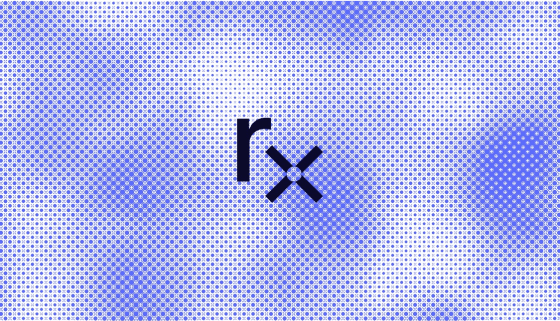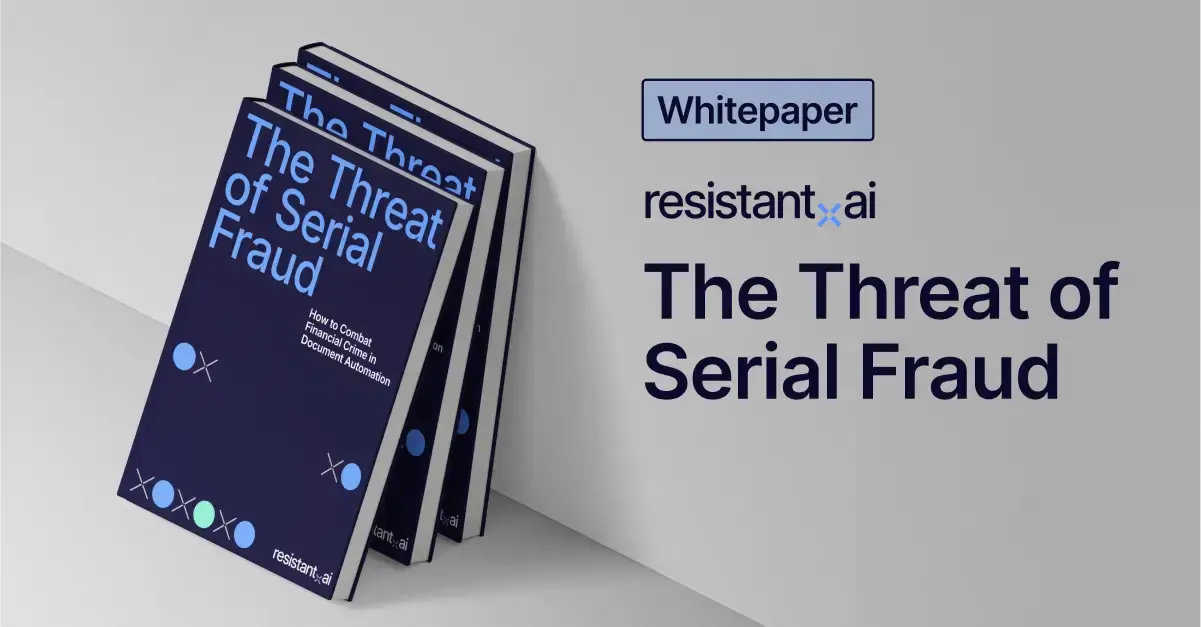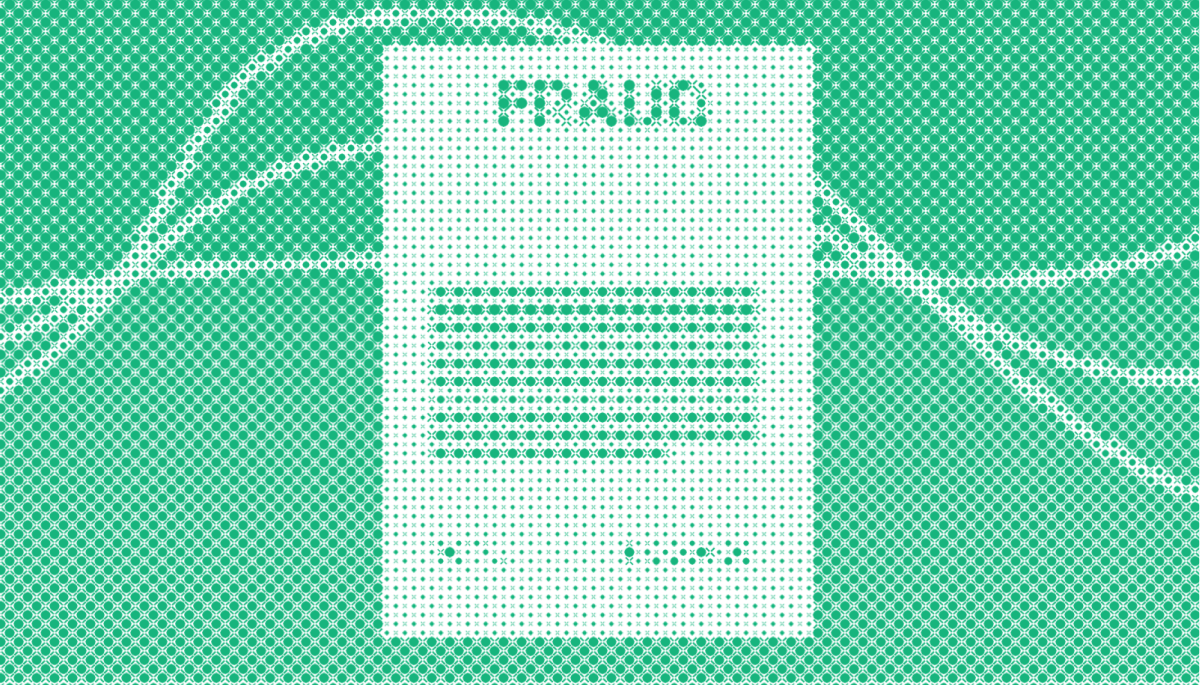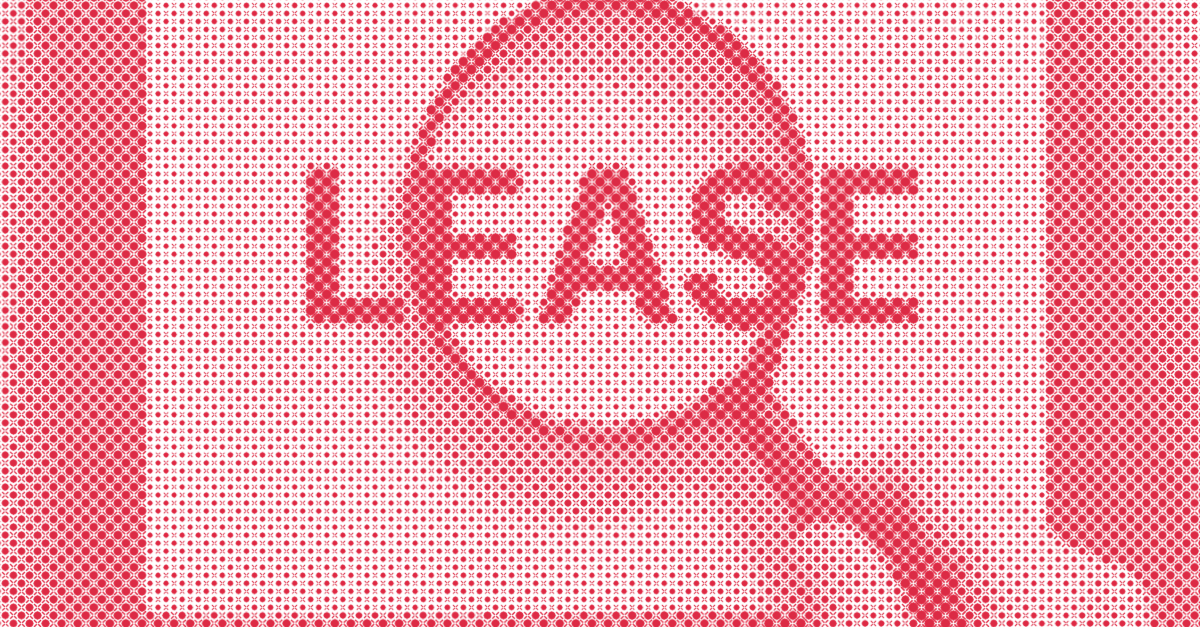How to spot mortgage fraud
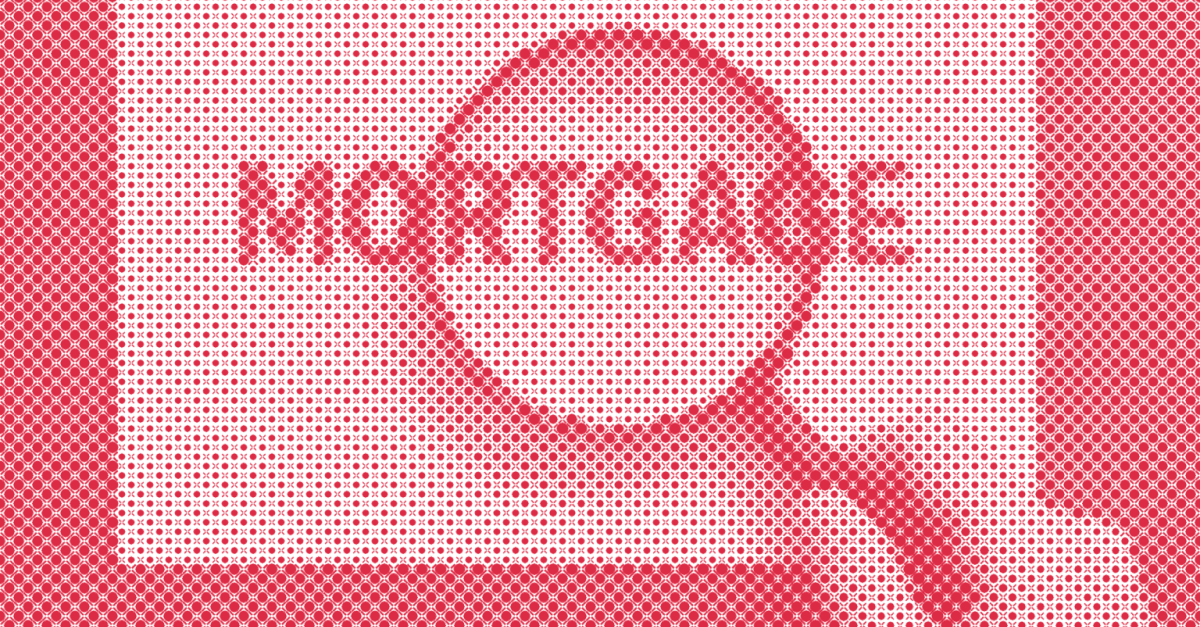


Mortgage fraud is booming in 2025, partly due to the rise of document fraud and the ease at which its committed.
When a few clicks on a computer can produce near-perfect forgeries, the number of fraudsters and frauds only continues to grow.
That’s why understanding and preventing mortgage fraud isn’t just important—it’s critical.
Read on to learn what mortgage fraud is, how its happening, how to identify mortgage fraud, how to prevent it, and how AI-powered document verification solutions can help.
Check out our "How to spot fake documents" blog to learn about more common document forgeries.
Table of contents
What is mortgage fraud?
Mortgage fraud refers to the misrepresentation or omission of material facts by the borrower, lender, or insider to gain an advantage during the mortgage underwriting process.
Some of the documents included in mortgage fraud are:
-
Income and employment. Pay stubs, W-2 forms, tax returns, bank statements, etc.
-
Property and transaction. Purchase agreements, property appraisals, title documents, deed, loan applications, etc.
-
Identity and residency. Drivers license, passport, utility bills, rental agreements, etc.
-
Supplementary. Credit reports, gift letters, letters of explanation, etc.

An example of a bank statement (a common document forged for mortgage fraud) for illustrative purposes only
How does mortgage fraud work?
Home loan fraud can be committed in a variety of ways, such as submitting fake documents, colluding with mortgage brokers, appraisers, and underwriters, and inflating property prices. The key is understanding why people commit home loan fraud in the first place.
What are the types of mortgage fraud?
1 in 134 mortgage applications contained indications of fraud in the second quarter of 2023.
Given these numbers, mortgage underwriters need to be stringent with their underwriting guidelines, conduct due diligence and be well aware of these 8 types of mortgage scams: income fraud, air loans, property fraud, appraisal fraud, occupancy fraud, asset rental fraud, inheritance fraud, and liability fraud.
Income fraud
Income fraud refers to a fraudulent misrepresentation, omission, or declaration of the applicant’s income or current employer. This typically entails the manipulation of documents such as:
-
Employer references
-
Fraudulent employer contracts
To prevent this specific type of fraud, we recommend loan underwriters working directly with employers. This ensures the applicant is still working with no recent changes such as a resignation, release, or retrenchment that could affect their ability to repay the loan.
Air loans
Also known as mortgage broker frauds, air loans happen when a mortgage broker creates a fictitious property, borrower, and eventual buyer to defraud the lender.
Fraudulent details and manipulations occur to items such as:
- Credit histories
- Employment contracts
- Identification numbers
Air loans are particularly damaging to lenders and financial institutions since the lack of real property or buyer means the funds tend to be irrecuperable.
Property fraud
Property fraud is a form of a mortgage scam where fraudsters doctor real estate deeds, purchase agreements, appraisals, or details within these documents to transfer ownership of a property.
These culprits tend to acquire, sell or mortgage the real estate asset by assuming the identity of the owner officially.
They even go as far as entering this in public administration, generating an official record that highlights a sale or mortgage that never took place. Here are some examples of how it works:
-
Secure mortgages illegally. Fraudsters may obtain mortgages on properties they don’t actually own–leaving lenders with defaulted mortgages and no legitimate claim to the collateral property.
-
Defaulted payments. Once real estate fraud is uncovered, homeowners are usually unwilling or unable to make repayments–leaving lenders empty-handed yet again.
-
Legal and reputation costs. When fraudsters are apprehended, lenders are stuck in long legal battles that make them vulnerable to additional penalties and potentially hefty consequences for unknowingly partaking in property fraud.
Appraisal fraud
Appraisal fraud, aka property flipping fraud, occurs when perpetrators purchase property, obtain a false appraisal, and then resell it at an inflated price.
This typically involves more than a single individual and can be easily classified into four main types:
-
Inflated appraisals
-
Misrepresentation of property information
-
Identity theft
-
Collusion
Keep in mind: Appraisal fraud can also go both ways. A property can be overvalued or undervalued.
Occupancy fraud
Occupancy fraud is one of the examples of mortgage scams where individuals falsely claim that they will live in the property they intend to purchase. They do this to secure:
-
Lower interest rates
-
Lower down payments
-
Higher approval odds
People who engage in occupancy fraud are 75% more likely to default on their mortgage.
Asset rental fraud
When unqualified borrowers borrow assets from others to appear qualified to obtain a mortgage its called asset rental fraud.
Personal assets are inflated such as:
-
Cash flow
-
Equity
-
Investments
-
Physical and non-physical assets
In some cases, borrowers can also forge genuine documents to prove their ownership of other people’s assets to obtain a fraudulent mortgage.
Inheritance fraud
Inheritance fraud happens when a business or individuals falsely proclaim to be an heir or beneficiary of a deceased person to gain legal access to their tangible and intangible assets such as real estate assets, investment bonds, etc.
Fraudsters can fabricate documents such as:
-
Wills
-
Power of attorney
Liability fraud
Liability fraud is a type of fraudulent mortgage where an applicant hides other financial commitments such as hefty student debts, car loans, or even additional mortgages during the mortgage loan underwriting process.
A mortgage loan underwriter must conduct due diligence such as checking an applicant’s credit report, bank statements, or even a title search to ensure there's no additional liabilities.
If you’d like to know how fraudsters are creating all these fake mortgage documents, check out our “Types of fraud” blog to learn more about their tactics.
Why do people commit mortgage/home loan frauds?
People primarily commit mortgage fraud for two reasons: to profit financially or to secure housing they might not otherwise qualify for.
Mortgage fraud for profit
Fraudsters who commit mortgage fraud for profit typically engage in activities like property fraud, appraisal fraud, and air loan fraud. Their goal is to manipulate the mortgage process to make quick money or launder illegal funds through real estate investments.
Mortgage fraud for housing
With the rise of inflation and a struggling economy, purchasing real estate is more difficult than ever, driving up first-party fraud. The perpetrators involved in this kind of home loan fraud tend to be individuals genuinely seeking to qualify for a mortgage–making them prone to document fraud or forgery to inflate incomes or hide bad credit histories.
5 Signs of mortgage fraud
Fraudsters often alter or fabricate documents such as W-2s, pay stubs, purchase agreements, appraisals, or even loan applications to deceive lenders and push unqualified loans through.
For mortgage underwriters attempting to spot fraud manually, an adept understanding of the universal mortgage fraud red flags in these documents is essential. Here are some tell-tale warnings to look out for:
1. Inconsistent formatting
Mortgage-related documents (like pay stubs, W-2s, and purchase agreements) follow standard layouts set by employers, government agencies, or real estate professionals. Forgeries frequently contain formatting anomalies such as:
-
Font mismatches. Varying font styles or sizes within the same document, especially for dollar amounts, Social Security numbers, or addresses.
-
Misaligned columns or fields. Pay stub figures not lining up correctly under earnings or deductions columns.
-
Blurry logos or seals. Employer logos or notary stamps appear pixelated or scanned from unrelated sources.
-
Missing or incorrect headers. Generic document headers like “Payment Summary” instead of “Wage and Tax Statement” on a W-2 form.
-
Improper document formats. Important forms provided in editable formats like Word or JPEG instead of password-protected PDFs or scanned originals.
2. Incorrect or misleading information
Falsified documents often contain data that doesn’t match what official databases or financial records would show:
-
Unverifiable employer names. Employers listed on W-2s or pay stubs that don’t exist or can’t be found online.
-
Inaccurate property values. Appraisal documents showing inflated home values far above comparable listings.
-
Conflicting addresses. Borrower’s mailing address on the application differs from utility bills or bank statements.
-
Mismatch between forms. Income listed on a pay stub doesn’t match what’s reported on the W-2 or tax return.
-
Wrong document issuer. Mortgage pre-approval letters claiming to be from a major bank but using an unrelated domain or missing branch information.
3. Bad math and uncharacteristic figures
Mathematical or contextual inconsistencies are common in fraudulent documents:
-
Round income figures. Monthly income conveniently listed as $5,000.00 on every pay stub, with no variation or overtime.
-
Unusual withholding amounts. Federal or state tax withholdings that don’t align with IRS tax brackets.
-
Inflated rental income: Stated income from rental properties that doesn’t match local market rates or lacks documentation.
-
Fake down payment sources: Gift letters for large down payments with no supporting bank statements or history of funds.
4. Mortgage document inconsistencies
Contradictions across multiple documents or terminology misuse are strong red flags:
-
Conflicting job titles. Different positions listed across pay stubs, employment letters, and the application.
-
Inconsistent borrower signatures. Signature style changes between the purchase agreement, loan application, and disclosures.
-
Wrong terminology. Use of generic phrases like “buyer” instead of “borrower,” or “monthly wage” instead of “gross monthly income.”
-
Date conflicts. Application date precedes the issuance of income or tax documents being used to support it.
5. Metadata Discrepancies
Even if a document looks legitimate on the surface, metadata can reveal its digital footprint:
-
Edited with consumer software. Metadata shows edits in Photoshop, Word, or Canva instead of documents exported from payroll or tax systems.
-
Incorrect authorship. Metadata lists unrelated individuals or companies as the document creator.
-
Creation date anomalies. A pay stub dated last month has a creation timestamp from the same day it was submitted.
-
No digital signature. Lenders or payroll platforms often embed signatures or cryptographic stamps—missing these can indicate tampering.
Disclaimer: Spotting these inconsistencies manually takes time and expertise — even trained eyes can miss subtle forgeries.
Mortgage fraud is evolving rapidly, and relying on AI-powered document verification is critical for detecting manipulation at scale and maintaining loan integrity.
Consequences of mortgage fraud
Mortgage fraud is an expensive lesson. Every mortgage home loan fraud contributes to a slew of issues that involve financial institutions, lenders, and more.
Here are some of the common repercussions of mortgage fraud:
Financial loss
More than a million American homeowners are 60 days behind on their mortgage repayments.
For lenders and financial institutions, repetitive defaulted repayments lead to foreclosures. This leads to a loss of all future interest payments, which directly decreases revenue.
Financial institutions also lose out on the collateral value of the property due to economic fluctuations in the market.
Increased liabilities
Mortgage fraud losses negatively impact loan loss reserves, creating a liability on the balance sheet.
When loan loss reserves increase, the amount of liability increases.
This directly affects profitability, retained earnings, and future capital of the lender. It also reduces the amount of assets a lender has at the end of a fiscal year.
Erosion of investors’ confidence and trust
Mortgage loan frauds in any fintech or financial institution indicate a lack of due diligence and bad lending practices.
Eroding the investors’ confidence and trust, this negatively impacts the lender’s reputation–making it difficult for them to sell their loans.
In the long run, lenders will struggle to survive and grow since loans remain unsold due to a tarnished reputation among investors.
How to prevent mortgage fraud?
The best way to prevent mortgage loan fraud is through a layered approach including a comprehensive mortgage fraud framework, protocols, and document verification solution.
Here’s how it works:
Establish a mortgage fraud framework
Categorize and incorporate mortgage fraud into the company’s protocols and policies. This includes structuring internal data, frameworks, and processes to manage home loan fraud when it arises.
Here are some ways on how to start:
Incorporate mortgage fraud protocols, policies, and processes
Training internal staff, provide access to mortgage fraud information, and utilize external resources such as an AI fraud detector.
These steps ensure all employees know what to do, where to report, and how to manage mortgage fraud cases once they arise.
Collect, consolidate, and categorize internal data
A database of fraud losses is an impactful way to combat mortgage fraud.
Start by creating a tracker that includes how much the company lost, the parties (brokers, solicitors, valuers, etc) involved, and any other relevant information.
Even a simple Excel sheet will work wonders. Monitoring these over time helps to detect fraud patterns, establish trusted partners, and encourage more stringent fraud controls in the future.
Document fraud detection tools and preventative measures
Since mortgage applications are mostly approved via assessing documents, understanding document fraud and putting measures in place to prevent it is essential.
The first (very necessary) step is to invest in a document fraud detection solution. Whether manual or automated, this will allow you to begin assessing the risk level of documents, develop rules for verification, and improve your collection systems over time.
How to detect mortgage fraud?
After setting preventative measures in place, detecting fraudulent, fake, or forged documents comes next.
Lenders can either manually underwrite mortgages or automate part of the process.
While manual reviews have their benefits, like being able to start right away, we find them slower and less reliable than AI powered solutions.
Conduct manual underwriting for mortgages
Experienced underwriters bring laser-sharp instincts and a keen eye for details to the table.
They tend to use their gut to detect suspicious activities, with confirmation through mortgage fraud red flags we mentioned above such as unsigned tax returns, etc.
Keep in mind: Conducting manual reviews can be prone to human error and doesn't scale. To effectively eliminate mortgage fraud at scale you will need an AI-powered document verification solution.
Using AI and Machine learning to spot mortgage fraud
Fighting document fraud in mortgage underwriting with the naked eye alone is a losing battle.
The best way forward is to transform a lender’s defense line by incorporating AI fraud detectors to prevent mortgage fraud has the following benefits:
Save time
Time is of the essence when it comes to approving mortgages. The time it takes to check each document, approve the mortgage, and investigate potentially fraudulent cases, can sometimes take weeks.
For private mortgage lenders who have employed an AI-powered document verification solution (like LYNK Capital), it only takes 2 minutes to conditionally approve home loans.
Fintech lenders and financial institutions can save up to 52 minutes per investigation (just like Habito, a UK-based mortgage broke).
The best part? Due to the efficiency of automated AI mortgage fraud solutions, it can manage a vast amount of mortgage applications.
Save money
Each lender is estimated to lose $4.40 for every dollar lost to mortgage fraud.
The only solution is to reduce the probability of mortgage lender fraud ahead of time–by incorporating AI mortgage fraud detection tools.
AI solutions document fraud during the application process, it saves any lender a substantial amount of money–which tends to include legal fees, defaulted housing loans, PR costs for brand image, etc.
Save relationships
A lender or financial institution’s profitability primarily depends on trust and its relationship with a borrower. However, the key is: knowing which borrower to trust.
With an AI fraud detection tool, mortgage lenders can catch 75% more fraud while knowing exactly who to lend to based on the documents submitted during the mortgage underwriting process.
This maintains a healthy status quo between lenders and borrowers without compromising on relationships or revenue.
Other benefits
Without overhauling the existing framework for mortgage underwriting, an AI fraud detector can also:
-
Hasten the decision-making process.
-
Be easy to install or incorporate.
-
Improve the defense framework.
-
Automate workflows.
-
Improve processing volume and time.
-
Provide insight into consumer data trends.
-
Connect to prior mortgage fraud cases.
-
Aid Compliance adherence.
Conclusion
As fintech lenders and financial institutions scale, understanding home loan/mortgage fraud is only the first step.
In this ever-changing landscape, incorporating AI fraud detection tools is the only way to stay ahead of the competition and the criminals.
Want to get started? Scroll down to book a demo.
Frequently asked questions (FAQs)
Hungry for mortgage fraud detection content? Here are some of the most frequently asked questions about mortgage fraud from around the web.
How to spot mortgage fraud with AI?
AI can spot mortgage fraud by analyzing patterns and inconsistencies across borrower-submitted documents, application data, and transaction records.
It uses machine learning models trained on known fraud cases to detect anomalies like mismatched income across documents, irregular employment history, or falsified pay stubs and W-2s.
With automation, AI can flag subtle document forgeries or synthetic identities at scale—far beyond what manual reviewers can catch.
What's the difference between mortgage fraud and predatory lending?
Mortgage fraud is typically committed by the borrower or a third party and involves intentional deception (e.g., falsifying income or occupancy status) to get a loan.
Predatory lending is committed by the lender and involves manipulating or misleading the borrower into accepting abusive or unfair loan terms (e.g., excessive fees, hidden clauses).
Mortgage fraud is a crime, while predatory lending often falls into regulatory violations or unethical practices that may or may not be illegal.
Is there software to detect mortgage fraud?
Yes, AI-powered platforms like Resistant AI offer mortgage fraud detection tools that verify document authenticity and detect synthetic identities or falsified financial data.
These tools cross-check information across multiple documents and data sources to catch fraud attempts early in the underwriting process. Software detection dramatically increases speed, accuracy, and fraud prevention effectiveness compared to manual review.
Who needs to detect mortgage fraud?
Several roles need to detect mortgage fraud, playing a critical part in protecting lenders from financial loss, legal exposure, and reputational damage.
Some of the most common are:
-
Loan officers and underwriters. Review applications and supporting documents to ensure borrower honesty and eligibility.
-
Fraud and risk teams. Monitor for suspicious patterns across loan portfolios and investigate anomalies.
-
Compliance officers. Ensure the institution meets regulatory standards and identifies high-risk activity before funding.
-
Mortgage servicers and secondary market buyers. Detect fraud post-origination to avoid purchasing or managing toxic assets.
How much does mortgage fraud cost the US a year?
In the US, mortgage losses resulting from poor debt management and foreclosures are estimated to cost $70.8M based on the first quarter of 2024.
How much does mortgage fraud cost the UK a year?
Mortgage fraud costs about £1.3 billion a year (based on 2016), where 84 out of every 10,000 applications are fraudulent.
Which state has the lowest mortgage fraud rate?
Based on CoreLogic’s mortgage fraud trend report, the infographic lists the area of St. Paul in Minneapolis as one of the least risky locations for mortgage fraud.
How do you protect against mortgage fraud in the US?
For mortgage lenders, the best way is to search for publicly available property tax records.
It should highlight the tax history and records of the property over time to help underwriters ascertain the total amount of taxes and its assessed values.
To search for property deeds, going to the county’s office directly should allow you to download and print property deeds for further assessment.
Of course, using a document fraud detection solution is also a great defense.
How do you protect against mortgage fraud in the UK?
Apart from a layered approach of underwriters and an AI fraud detector, firms, and homeowners can go one step further by signing up for the free property alert service.
It sends alerts on changes regarding chosen properties such as a new mortgage, change of ownership, etc for up to 10 real estate assets. In addition, businesses and homeowners are highly recommended to request a “Form LL Restriction” to protect their real estate assets
Why is mortgage fraud on the rise?
Mortgage fraud attempts surged by more than one-third between 2022–2023, leaving mortgage originators and brokers more vulnerable to mortgage lender fraud.
Worse yet, the shift to digital interactions has made home loan underwriting much more challenging. Anyone with a computer can easily edit PDFs of bank statements or other documents in a way that can be hard to detect with the naked eye.
And if those amateurish attempts don’t work, there are plenty of online template farms that provide much higher quality, pre-made, editable document templates of any document needed for mortgage fraud. One such example is Doc Juicer, the largest template farm on record spanning over 18k templates across 50+ template categories.
In our document fraud webinar, Jan Syrinek, Resistant AI’s Head of Product, highlighted how fraudulent tools are available to the public–especially with new generative AI capabilities.
’Generative AI not only helps create higher quality forgeries, it also helps to accelerate automation. And I think that’s the key thing here, that it makes automation more accessible to everybody—including fraudsters.’
In other words, the arms race is on, and relying on manual document reviews in mortgage underwriting processes is no longer tenable for home loan providers.

